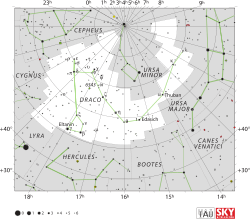Chi Draconis

| |
| Observation data Epoch J2000 Equinox J2000 | |
|---|---|
| Constellation | Draco |
| Right ascension | 18h 21m 03.38255s[1] |
| Declination | +72° 43′ 58.2518″[1] |
| Apparent magnitude (V) | 3.570[2] (3.68 / 5.67) |
| Characteristics | |
| Spectral type | F7V[3] / K0V |
| U−B color index | -0.06 |
| B−V color index | 0.49 |
| Variable type | Suspected |
| Astrometry | |
| Radial velocity (Rv) | +32.4[2] km/s |
| Proper motion (μ) | RA: 531.21[1] mas/yr Dec.: -349.71[1] mas/yr |
| Parallax (π) | 124.11 ± 0.87[1] mas |
| Distance | 26.3 ± 0.2 ly (8.06 ± 0.06 pc) |
| Absolute magnitude (MV) | 4.04[2] |
| Orbit[4] | |
| Companion | Chi Draconis B |
| Period (P) | 0.7680599 ± 0.000061 yr |
| Semi-major axis (a) | 0.1244 ± 0.0011" |
| Eccentricity (e) | 0.428 ± 0.012 |
| Inclination (i) | 74.42 ± 0.58° |
| Longitude of the node (Ω) | 230.30 ± 0.51° |
| Periastron epoch (T) | 1984.8324 ± 0.0026 |
| Argument of periastron (ω) (secondary) | 119.3 ± 1.1° |
| Details | |
| χ Dra A | |
| Mass | 1.029 ± 0.026[5] M☉ |
| Radius | 1.20 ± 0.09[5] R☉ |
| Luminosity | 1.86[5] L☉ |
| Temperature | 6,150 ± 150[5] K |
| Metallicity [Fe/H] | −0.41[2] dex |
| Rotational velocity (v sin i) | 11[6] km/s |
| Age | 5.3[2] Gyr |
| χ Dra B | |
| Mass | 0.748 ± 0.017[5] M☉ |
| Radius | 0.73 ± 0.11[5] R☉ |
| Luminosity | 0.29[5] L☉ |
| Temperature | 4,940 ± 200[5] K |
| Other designations | |
Chi Draconis (χ Dra, χ Draconis, Chi Draconis) is a star system in the constellation Draco.
The first companion is a yellow-white (class F) fourth-magnitude star with a mass approximately equal to that of the sun, but it is nearly twice as luminous. The second companion is an orange (class K) sixth-magnitude star, that is less massive and of lesser luminosity than the sun. In 1898 this system was reported to be a spectroscopic binary system, with an orbital period of 280.55 days. The two stars have an average separation of nearly an astronomical unit, which would disrupt the orbit of any Earth-like planet that was close enough to the primary to support liquid water. The two stars have less than half the abundance of heavy elements as the Sun and are approximately a billion years older.[2]
In fiction
See also
References
- 1 2 3 4 5 van Leeuwen, F. (November 2007), "Validation of the new Hipparcos reduction", Astronomy and Astrophysics, 474 (2): 653–664, arXiv:0708.1752
 , Bibcode:2007A&A...474..653V, doi:10.1051/0004-6361:20078357
, Bibcode:2007A&A...474..653V, doi:10.1051/0004-6361:20078357 - 1 2 3 4 5 6 Nordström, B.; et al. (May 2004), "The Geneva-Copenhagen survey of the Solar neighbourhood. Ages, metallicities, and kinematic properties of ˜14 000 F and G dwarfs", Astronomy and Astrophysics, 418: 989–1019, arXiv:astro-ph/0405198
 , Bibcode:2004A&A...418..989N, doi:10.1051/0004-6361:20035959
, Bibcode:2004A&A...418..989N, doi:10.1051/0004-6361:20035959 - 1 2 "chi Dra -- Star in double system", SIMBAD, Centre de Données astronomiques de Strasbourg, retrieved 2011-10-15
- ↑ Farrington, C. D.; et al. (June 2010), "Separated Fringe Packet Observations with the CHARA Array. I. Methods and New Orbits for χ Draconis, HD 184467, and HD 198084", The Astronomical Journal, 139 (6): 2308–2318, Bibcode:2010AJ....139.2308F, doi:10.1088/0004-6256/139/6/2308
- 1 2 3 4 5 6 7 8 Torres, G.; Andersen, J.; Giménez, A., "Accurate masses and radii of normal stars: modern results and applications", The Astronomy and Astrophysics Review, 18 (1-2): 67–126, arXiv:0908.2624
 , Bibcode:2010A&ARv..18...67T, doi:10.1007/s00159-009-0025-1 See p. 56, entry #15.
, Bibcode:2010A&ARv..18...67T, doi:10.1007/s00159-009-0025-1 See p. 56, entry #15. - ↑ Monin, D. N.; Fabrika, S. N.; Valyavin, G. G. (2002). "Magnetic survey of bright northern main sequence stars". Astronomy & Astrophysics. 396 (1): 131–141. Bibcode:2002A&A...396..131M. doi:10.1051/0004-6361:20021425.
External links
- ARICNS
- Chi Draconis 2 at SolStation.
- nStars database entry